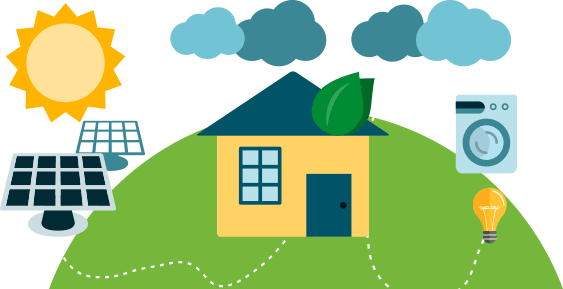Solar Electronics: Off Grid and On Grid Solar Inverter
A solar power system has several key components, including solar panels, mounting structure, solar inverter, cables, connectors, and a solar battery if it is an off-grid module. While solar PV panels are often considered the most crucial element of solar energy solutions, even the inverter plays a vital role in solar power generation.
Solar inverters are electrical devices designed to convert Direct Current (DC) harnessed by the PV solar panels into Alternating Current (AC). Since both household and commercial appliances such as air conditioners, fans, geysers, washing machines, and refrigerators require Alternating Current (AC) to function and solar panels produce Direct Current (DC), solar inverters carry out the conversion process.
Although the primary purpose of solar inverters is to Direct Current (DC) into Alternating Current (AC), today, inverters come with other advanced capabilities such as utility controls and data monitoring, helping you keep tabs on your solar panel system.
The Various Types of Solar Inverters
While all solar inverters have the same function, you can choose a variation depending on which solar power system you install, plus your unique power requirements. Solar inverters can be categorized into the following 3 types:
- Grid-Tie Inverter/On-Grid Solar Inverter
- Off-Grid Solar Inverter
- Hybrid Solar Inverters
Now that we know the basics of solar inverters let’s understand grid-tie inverters/on-grid solar inverters, off-grid solar inverters, and hybrid solar inverters in detail.
1. Solar On-Grid Inverter
As the name suggests, on-grid or grid-tie solar inverters remain connected to the local power grid, which is why these inverters only function when both grid and solar power is available. Additionally, any excess solar electricity is sent back to the grid, resulting in savings on utility bills. This cost-effectiveness makes on-grid solar systems, including on-grid inverters, more popular and economical.


2. Off-Grid Solar Inverter
An off-grid solar inverter, also sometimes referred to as a stand-alone solar inverter, is independent of the local power grid, unlike grid-connected inverters. Traditionally used with off-grid solar power systems, this inverter solely functions on the solar energy produced by the photovoltaic panels. However, any excess electricity is sent to the solar battery instead of the grid, giving you sufficient power backup during outages.
3. Hybrid Solar Inverter
Although quite similar to grid-tie PV inverters, hybrid solar inverters are somewhat complex. This is because the hybrid solar power system can simultaneously use multiple power sources like solar PV panels, local grids, and battery storage. However, these solar inverters primarily function on solar power but shift to the local grid when solar energy cannot be generated like during the night.

Solar Inverter Technologies
Once you’ve figured out which solar inverter will work best for you, the next step is to choose the inverter technology. Whether you’re buying an on-grid solar inverter or an off-grid inverter, there are two types of technologies available in the Indian market:
PWM Solar Inverters – The Pulse Width Modulation (PWM) technology is best suited for off-grid solar inverters with a rating of less than 2KW. Typically used in remote and rural areas, off-grid inverters built with PWM technology are efficient yet economical.
MPPT Solar Inverters – The Maximum Power Point Tracker (MPPT) technology comes built-in with on-grid/grid-tie inverters. While MPPT-enabled solar inverters are highly efficient, they are also comparatively expensive than Pulse Width Modulation (PWM) technology.
Here is a brief comparison between the two:
| Feature | Pulse Width Modulation (PWM) | Maximum Power Point Tracker (MPPT) |
|---|---|---|
| Suitable For | Off-Grid Solar Inverters | Grid-Tie Solar Inverters |
| Efficiency | Standard, 65 to 70% | High, more than 95% |
| Cost | Low-Cost | Quite Expensive |
| Availability | Easily Available | Easily Available |
Luminous’ Solar Inverter Range
Luminous offers a vast collection of high-quality and efficient solar inverters, both on-grid and off-grid, across different technologies. Our best-selling ranges include the NXG UPS, NXT PCUs, NXi Grid Tie, and Cruze Solar. So, whether you’re opting for an on-grid solar power model or an off-grid solar power model, we offer the best-in-class solar inverters to keep your appliances running all day. Even better, Luminous solar inverters are equipped with some stand-out features and advantages, so let’s take a look:
Grid-Tie Solar Inverter Range Features
- High efficiency, greater than 97%
- Dual/Quad MPPT charge controllers for complete utilization of PV arrays even in partial shading and increasing efficiency
- Designed with IP65 protection to work in tough weather conditions and deliver flawless operation despite dust, rain, or extreme temperature variations
- Complies with MNRE recommended standards: IEC – 61683, IEC – 60068, IEC – 61000, IEC – 61727, IEC – 62116, approved for government subsidies.
- Multiple modes of connectivity (GSM/Wi-Fi) for remote monitoring
Off-Grid Solar Inverter Range Features
- Maximum utilization of solar power with inbuilt MPPT charge controller
- Protection from internal surges and noises with inbuilt O/P isolation transformer
- Selectable source priority among Solar, Battery, and Grid
- High current-handling capability, preventing thermal losses
- Short circuit protection for AC (Alternating Current) and DC (Direct Current)
- Remote monitoring through a mobile application
In addition to these features and advantages, Luminous’ high-performance solar inverters are available in power capacities ranging from below 1500VA to 5KW for 1P application and 5KW to 100kW for 3P application.
So, explore our range of on-grid solar inverters and off-grid solar inverters and equip your solar power system with only the best.
Don’t know where to start? Book a free consultation today and get started with your journey towards clean & renewable energy!

